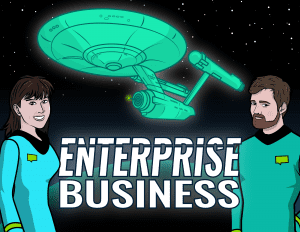
What is enterprise learning?
For those unfamiliar to the L&D industry, enterprise may conjure up thoughts of a popular noughties Star-Trek series. Not to mention being the name of countless teams on The Apprentice.
In Learning and Development, Enterprise Business is simply defined as a big business with lots of employees across lots of different departments.
If an enterprise expands rapidly, then training ethics can wane.
Substandard training will have a negative, trickle-down effect on the whole company in one way or another.
Join us as we delve into the challenges facing enterprise learning and what we can do to battle this evil!
What is Considered an Enterprise Business?
Have you ever wondered how large a workforce has to be to be considered an enterprise business? Here’s some handy bullet-points to break it down:
-
- Micro Sized Business – 1 – 9 employees
- Small Sized Business – Less than 100 employees
- Small/Medium Sized Business – 100 – 999 employees
- Medium Sized Business – 1,000 – 9,999 employees
- 10,000 – Large/Enterprise Business
As you can imagine, 10,000 employees or more can be a lot to handle! Creating a sense of unity is the biggest overall challenge facing enterprise learning. Social learning can do this by linking the company via tools such as virtual clubs.
Four Challenges that Face Enterprise Businesses when Training:
Challenge 1: Promoting Healthy Competition in Learning

Encouraging healthy competition is awesome as 50% of workers gain a positive learning experience from it.
Naturally, an enterprise business may find it challenging to encourage healthy competition on a large scale. This is due to different departments, and separate teams, unintentionally shrinking the team spirit! There is, however, a remedy for this…
The Battle Plan
A Learning Management System is great for encouraging healthy competition between separate departments, teams and individuals. The fantastic thing is, it doesn’t matter where in the world you are! It will boost morale and help pull employees together.
Our award-winning Academy Academy LMS boosts healthy competitiveness in a variety of awesome ways. Here are just a few examples of how it achieves this:
Levels
You can create levels on an LMS which describe what stage of learning you are at. Usually, each company will configure at least three levels: beginners, intermediate and expert. The names of these levels can also be personalised to reflect the culture of your business.
Inject some exciting competition into your learning programme by seeing which department/country can elevate the most employees to expert level in a limited time period!
Leaderboards
On our Academy LMS, we drive lively contests via leaderboards. This is executed by a points system and virtual badges. If you complete an assessment, a test or a quiz, then you’ll move up on the leaderboard.
You can have a top learner of the month leaderboard, a top learner of the year, a leaderboard for new employees in every department, and even an all-time top scoring leaderboard!
Why not create your own leaderboard showing the top learners in each department? Leaderboards are a brilliant way to rev up some healthy competition and team spirit. Let the fun begin and remember, it’s just a game…
Rewards
Once you have your game mechanics in place, you should also consider implementing a rewards system which gives your learners an opportunity to trade their virtual rewards for real world rewards. This gives your learners even more of an incentive to win!
The rewards are totally your choice. Need some inspiration? Some ideas for rewards could include a day’s holiday or online shopping vouchers.
Why not buy lunch as a reward for the department who can gain the most points in a month? (Yes, this is a shameless hint to my management!).
Challenge 2: Giving Individuals a Voice

With a large enterprise company, you can sometimes feel like a small cog in a giant machine: unimportant, unessential and uninspired. Change this by creating a culture where every single team member feels like they matter.
The Battle Plan
Shift focus onto the individual by offering a customised learning platform. This will make your learners feel like a part of the team, even in a large-scale enterprise company.
On a nextgen LMS, each user will have their own space they can customise.
Here’s a list of what they can make their own on the Academy LMS profile:
- Profile Picture
- Job Title
- Bio
- Work History
- Qualifications
- Interests
- Showcases
Personalised profiles are an awesome way for workers in different departments/locations to get know each other and build rapport. The better the rapport, the stronger the social learning will be.
Now they’re not just another brick in a wall; they have a face and a voice. They’ll feel invested in a company who cares about them and their engagement levels will shoot through the roof!
Challenge 3: Making Learning Personal

Can you believe that some enterprise businesses use scale and distance as an excuse to not be personal to their workforce? This is a sure-fire way to make colleagues feel unengaged and will lead to low productivity.
Battle Plan
With modern technology, there are no excuses when it comes to adding a personal touch to enterprise learning, wherever your workers are in the world. Video streams have killed the phone call!
Nowadays, we can see people’s mannerisms, their facial expressions and the delicate touches that you can only get in a face-to-face meeting, even if your seminar/meeting is on the other side of the world.
Personal touches can also be added by implementing an individual learning timeline to each profile. This will mark out the unique learning journey for each employee.
Most LMSs will include a ‘My Things to Do’ section, mapping out the content that needs to be covered by individual workers.
Final Word
An enterprise business doesn’t have to mean disengaged staff or uninspired enterprise learning. LMSs have enabled large scale companies to promote healthy competition via leaderboards and XP and levels.
Employees at enterprise businesses can also suffer from a feeling of insignificance. Personalising profiles lets the customer know their importance and gives them a voice.
These tools help to keep the workforce of a huge enterprise feeling engaged and most importantly, valued.








